Jaybird180
Final Approach
Scenario:
Pilot John is flying Bugsmasher N12345 into airport KABC which is at Sea Level, MDA 999, Forecasts are stable with 2,000 foot ceilings and 3miles viz at the Class G airport with a high volume of flight training.
John is VFR-On Top with tops at 12,000 and cleared for the approach.
What systems/ procedure are in place to ensure there is no 91.111 violation since everyone is following the rules?
Change the celing to 1,001 (flight training still legal) and also discuss.
Pilot John is flying Bugsmasher N12345 into airport KABC which is at Sea Level, MDA 999, Forecasts are stable with 2,000 foot ceilings and 3miles viz at the Class G airport with a high volume of flight training.
John is VFR-On Top with tops at 12,000 and cleared for the approach.
What systems/ procedure are in place to ensure there is no 91.111 violation since everyone is following the rules?
Change the celing to 1,001 (flight training still legal) and also discuss.



 It wasn't intended to be but as soon as I left the building I realized it might be read that way.
It wasn't intended to be but as soon as I left the building I realized it might be read that way.